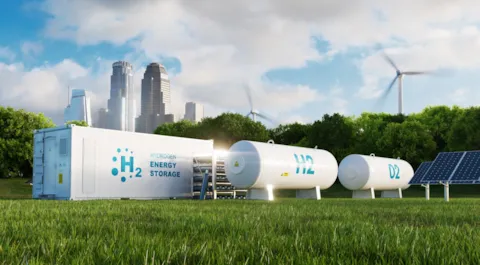Navigating hydrogen standards
ASME’s TGP-1 guidelines explained
Recently, DNV hosted a webinar designed to help developers create a winning feasibility study for hydrogen projects. This experience reinforced that we urgently need an elevated dialogue around risk management in hydrogen projects.
Developers are progressing a growing number of hydrogen projects across North America backed by large volumes of capital from investors. Missing from the equation, however, is the necessary understanding of and experience mitigating risks.
This confluence of big money plus fast-paced delivery creates a situation we at DNV call undisciplined capital (check out this excellent article on the topic by Marion Hill). What happens is that undisciplined capital flows into projects with aggressive timelines that progress without proper risk mitigation.
Unfortunately, this can lead to project slowdowns or failure. Fortunately, the industry has access to tools and expertise to prevent this from happening.
The American Society of Mechanical Engineers' (ASME) TGP-1 guidelines
The ASME commissioned DNV to create a guidance and gap analysis document to accelerate the rollout of hydrogen economy. DNV was a natural choice for this project. We recently completed or are delivering technical due diligence and advisory services for fifteen hydrogen projects in Europe and North America.
As the point person for this project, I led a cross-functional team of technical experts and engineers to summarize existing standards in hydrogen value chains and identify the relevant standards for specific hydrogen applications.
While developing the guidelines, my team focused on two specific risks:
- Technical complexity and safety: hydrogen is highly flammable - production, storage, and distribution involve intricate processes and technologies, and handling and transporting it safely demands stringent safety protocols. Leak detection, emergency response, and risk mitigation strategies, as well as compatibility with existing infrastructure, such as pipelines, storage tanks, and transportation networks are critical to prevent accidents. Developing efficient and safe systems requires substantial research, engineering, and innovation.
- Storage and distribution: significant investment is required to scale up an efficient, comprehensive transportation and storage infrastructure system that can safely accommodate hydrogen's low volumetric energy density. The industry must quickly build out the pipelines, refueling stations, and high-pressure tanks to safely bring liquid or solid-state hydrogen to end users.
Understanding these risks will help prevent an influx of undisciplined capital into the sector. Undisciplined capital is a challenge impacting the entire renewable energy sector, and its impacts include an erosion of long-term ROI, as developers face project slowdowns or cancellations stemming from local community opposition or technical failures.
A wide range of users, such as engineers, managers, owners, system operators, manufacturers, the public, inspection parties, regulators, and other stakeholders can quickly get high-level insights and identify relevant codes and standards for their various applications. Click here to read the guidelines.
Creating a tool that delivers meaningful value
Because trust matters, I believe that the process to develop the guidelines is just as important as the finished product.
Together, our team reviewed ASME’s hydrogen portfolio and other organizations’ publications related to hydrogen codes and standards, developed a practitioner-friendly guide for ASME standards, and identified gaps in current hydrogen standards to be addressed. Standards published by other organizations such as API, ISO, AMPP (Formally NACE), and CGA are also discussed and included where relevant.
DNV’s methodology included assessment and characterization of:
- Where the document lies on the hydrogen landscape.
- The audience the document is addressing, e.g., manufacturers, designers.
- Usability of the documents within the hydrogen industry landscape (high-level).
- Areas of confusion (if any) concerning the use of the documents.
We identified numerous programs worldwide, both completed and in progress, that tackle the challenges of transitioning to hydrogen. Much of the existing guidance on hydrogen was created for new designs, often focusing on pure hydrogen service. However, these standards and guidelines may not cover all the factors needed for converting existing infrastructure, such as blending hydrogen into existing natural gas systems at lower concentrations.
Our work in this space is a critical first step towards the long-term d evelopment of recognized international standards which will ensure disciplined investment in and delivery of hydrogen projects across countries and regions. This knowledge is being expanded through ongoing lab research, testing programs, pilot studies, and early hydrogen deployment efforts.
DNV is ready to help you win in hydrogen
Recently my colleagues published an article exploring “What is good hydrogen?” (worth a read). Our premise is simple - good hydrogen starts with the right safety processes and systems. The ASME TGP-1 guidelines are a critical step forward in getting the industry closer to good hydrogen.
Getting this right means that projects can move forward and generate revenue because people will feel comfortable with hydrogen being produced, used, and transported in their back yards.
Of course, there are more resources available. DNV is ready to play its part to help developers reach a final investment decision faster and progress seamlessly into construction and then operations. We are also ready to help investors find winning hydrogen projects.
Reach out to me to learn more, or you can plan to meet with DNV at the upcoming World Hydrogen Congress North America in May and Argus Ammonia Conference in June.
4/3/2024 1:00:00 PM
